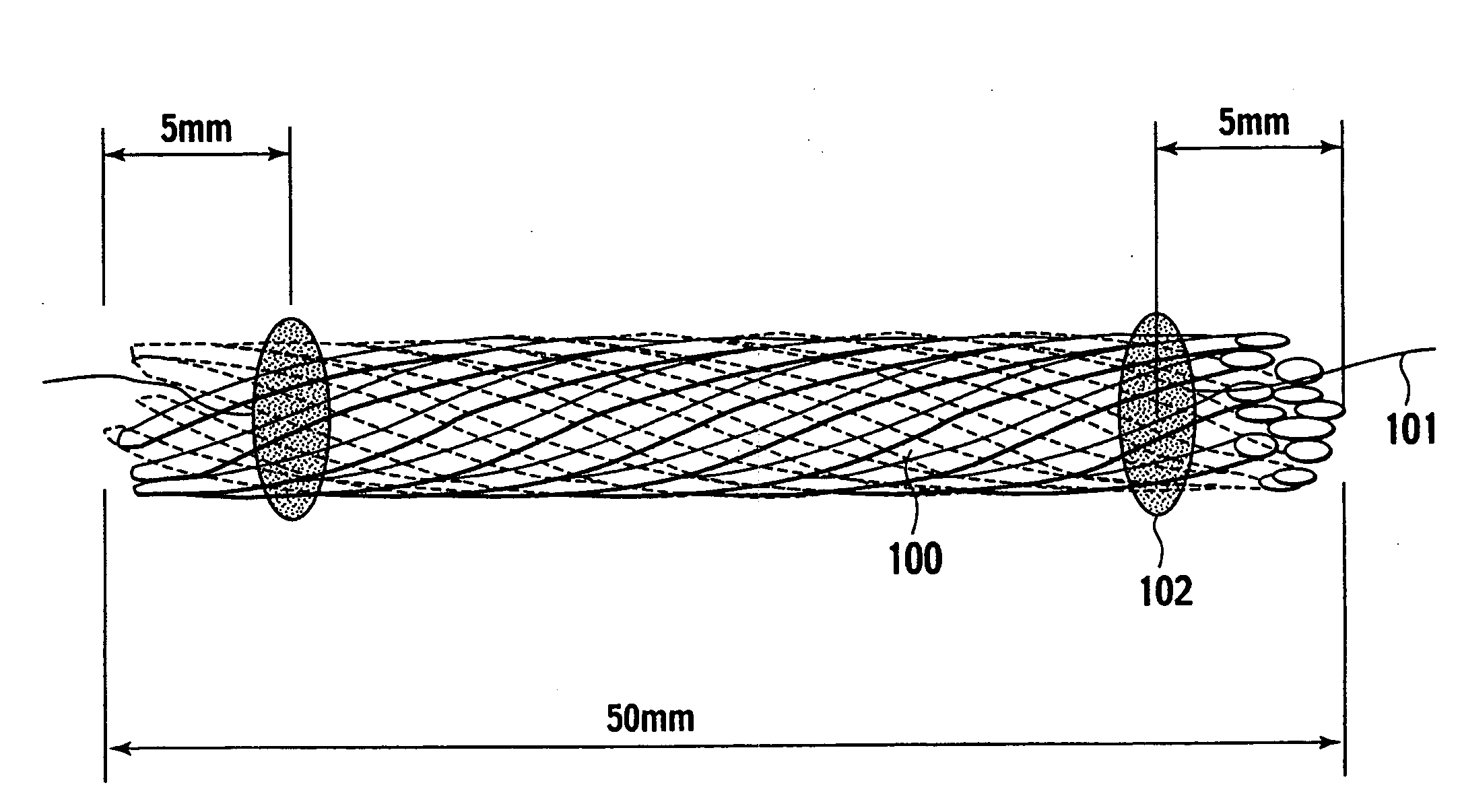Variable-airflow cloth, sound absorbing material, and vehicular part
a technology of airflow cloth and sound absorption material, applied in the field of cloth, can solve the problems of electrolysis, excessive energy, and performance decline due to leakage of electrolytic solution, and achieve the effect of reducing weight and saving spa
- Summary
- Abstract
- Description
- Claims
- Application Information
AI Technical Summary
Benefits of technology
Problems solved by technology
Method used
Image
Examples
example 1
[0153]Electrical-conductive polymeric fibers were fabricated by a wet spinning method. Specifically, acetone (Code No. 019-00353, made by Wako Pure Chemical Industries, Ltd.) was used for a solvent phase, and PEDOT / PSS (Baytron P (registered trademark)) as an electrical-conductive polymeric component was extruded from a microsyringe (MS-GLL100 made by Ito Corporation; inner diameter of needle portion: 260 μm) at a speed of 0.5 mL / h, whereby electrical-conductive polymeric fibers with a diameter of approximately 10 μm were obtained. Next, an aqueous polyester emulsion (AA-64, made by Nippon NSC Ltd.) was applied on surfaces of the fibers, followed by drying at 25° C. for 24 hours. Composite fibers thus obtained had a crescent cross-sectional shape of a stack type, and a diameter thereof was approximately 17 μm.
[0154]Next, a web was formed of mixed fibers composed of 80 mass % of the composite fibers cut to an average cut length of 50 mm and 20 mass % of binder fibers [core component:...
example 2
[0157]Composite fibers were fabricated by a wet spinning method similar to that in Example 1. Specifically, acetone was used for a solvent phase, and PEDOT / PSS (Baytron P (registered trademark)) as an electrical-conductive polymeric component and an aqueous solution prepared by diluting a water dispersion (Product No. 56122-3 made by Aldrich Corporation) of polystyrenesulfonate (PSS) to 10 times were extruded from two microsyringes (MS-GLL100 made by Ito Corporation; inner diameter of needle portion: 260 μm) at a speed of 0.5 mL / h into the same solvent phase. In such a way, composite fibers were obtained, in which a cross section had a shape shown in (n) of FIG. 13, and a length of the longest portion of the cross section was approximately 14 μm. In a wet spinning machine 90 shown in FIG. 40, such spinning raw liquids were extruded from two wet spinning mouthpieces 91, and extruded precursors 92 of the composite fibers were made to pass through a wet spinning solvent bath 93 that co...
example 4
[0160]By a wet spinning method similar to that in Example 2, composite fibers were obtained, in which a length of the longest portion of a cross section was approximately 14 μm. Next, 100 composite fibers thus obtained were bundled to form an aggregate. Next, a web was formed of mixed fibers composed of 80 mass % of the aggregate of the fibers cut to an average cut length of 50 mm and 20 mass % of binder fibers [core component: PET; sheath component: copolymer polyester (amorphous polyester); softening point: 110° C.] with a diameter of 14 μm by the airlaid method. Then, the web was compressed to a specific thickness (approximately 8 mm), and was then heated at 160° C. for seven minutes, whereby cloth with an average apparent density of 0.025 g / cm3 and a thickness of 10 mm was obtained. By using this cloth, variable-airflow cloth was obtained in a similar way to Example 1.
PUM
| Property | Measurement | Unit |
|---|---|---|
| softening point | aaaaa | aaaaa |
| softening point | aaaaa | aaaaa |
| diameter | aaaaa | aaaaa |
Abstract
Description
Claims
Application Information
 Login to View More
Login to View More - R&D
- Intellectual Property
- Life Sciences
- Materials
- Tech Scout
- Unparalleled Data Quality
- Higher Quality Content
- 60% Fewer Hallucinations
Browse by: Latest US Patents, China's latest patents, Technical Efficacy Thesaurus, Application Domain, Technology Topic, Popular Technical Reports.
© 2025 PatSnap. All rights reserved.Legal|Privacy policy|Modern Slavery Act Transparency Statement|Sitemap|About US| Contact US: help@patsnap.com



